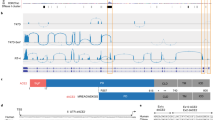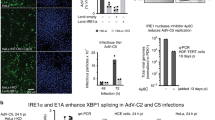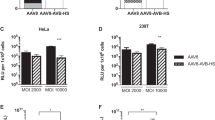Abstract
Adeno-associated virus 2 (AAV)-based vectors have gained attention as a potentially useful alternative to the more commonly used retroviral and adenoviral vectors for human gene therapy. Although AAV uses the ubiquitously expressed cell surface heparan sulfate proteoglycan (HSPG) as a receptor, the transduction efficiency of AAV vectors varies greatly in different cells and tissues in vitro and in vivo . We demonstrate here that cell surface expression of HSPG alone is insufficient for AAV infection, and that AAV also requires human fibroblast growth factor receptor 1 (FGFR1) as a co-receptor for successful viral entry into the host cell. We document that cells that do not express either HSPG or FGFR1 fail to bind AAV and, consequently, are resistant to infection by AAV. These non-permissive cells are successfully transduced by AAV vectors after stable transfections with cDNAs encoding the murine HSPG and the human FGFR1. Furthermore, AAV infection of permissive cells, known to express both FGFR1 and the epidermal growth factor receptor, is abrogated by treatment of cells with basic fibroblast growth factor, but not with epidermal growth factor. The identification of FGFR1 as a co-receptor for AAV should provide new insights not only into its role in the life cycle of AAV, but also in the optimal use of AAV vectors in human gene therapy.
This is a preview of subscription content, access via your institution
Access options
Subscribe to this journal
Receive 12 print issues and online access
$209.00 per year
only $17.42 per issue
Buy this article
- Purchase on Springer Link
- Instant access to full article PDF
Prices may be subject to local taxes which are calculated during checkout







Similar content being viewed by others
References
Berns, K.I. & Giraud, C. Biology of adeno-associated virus. Curr. Top. Microbiol. Immunol. 218, 1– 23 (1996).
Srivastava, A., Lusby, E.W. & Berns, K.I. Nucleotide sequence and organization of the adeno-associated virus 2 genome. J. Virol. 45, 555– 564 (1983).
Kotin, R.M., Menninger, J.C., Ward, D.C. & Berns, K.I. Mapping and direct visualization of a region-specific viral DNA integration site on chromosome 19q13-qter. Genomics 10, 831–834 (1991).
Samulski, R.J. et al. Targeted integration of adeno-associated virus (AAV) into human chromosome 19. EMBO J. 10, 3941– 3950 (1991).
Kearns, W.G. et al. Recombinant adeno-associated virus (AAV-CFTR) vectors do not integrate in a site-specific fashion in an immortalized epithelial cell line. Gene Ther. 3, 748–755 (1996).
Ponnazhagan, S. et al. Lack of site-specific integration of the recombinant adeno-associated virus 2 genomes in human cells. Hum. Gene Ther. 8, 275–284 (1997).
Qing, K.Y. et al. Role of tyrosine phosphorylation of a cellular protein in adeno-associated virus 2-mediated transgene expression. Proc. Natl. Acad. Sci. USA 94, 10879–10884 ( 1997).
Qing, K.Y. et al. Adeno-associated virus type 2-mediated gene transfer: Correlation of tyrosine phosphorylation of the cellular single-stranded D sequence-binding protein with transgene expression in human cells in vitro and murine tissues in vivo. J. Virol. 72, 1593 –1599 (1998).
Fisher K.J. et al. Transduction with recombinant adeno-associated virus for gene therapy is limited by leading strand synthesis. J. Virol. 70, 520–532 (1996).
Ferrari, F.K., Samulski, T., Shenk, T. & Samulski, R.J. Second-strand synthesis is a rate limiting step for efficient transduction by recombinant adeno-associated virus vectors. J. Virol. 70, 3227–3234 (1996).
Muzyczka N. Use of adeno-associated virus as a general transduction vector for mammalian cells. Curr. Top. Microbiol. Immunol. 158, 97–129 (1992).
Summerford, C. & Samulski, R.J. Membrane-associated heparan sulfate proteoglycan is a receptor for adeno-associated virus type 2 virions. J. Virol. 72, 1438– 1445 (1998).
Ponnazhagan, S. et al. Adeno-associated virus type 2-mediated transduction of primary human bone marrow-derived CD34+ hematopoietic progenitor cells: Donor variation and correlation of transgene expression with cellular differentiation. J. Virol. 71, 8262–8267 (1997).
Ponnazhagan, S. et al. Differential expression from the p6 promoter of human parvovirus B19 in human cells following plasmid transfection and recombinant adeno-associated virus 2 (AAV) infection: Human megakaryocytic leukaemia cells are non-permissive for AAV infection. J. Gen. Virol. 77, 1111 –1122 (1996).
Lebakken, C.S. & Rapraeger, A.C. Syndecan-1 mediates cell spreading in transfected human lymphoblastoid (Raji) cells. J. Cell Biol. 132, 1209– 1221 (1996).
Kiefer, M.C. et al. Ligand-affinity cloning and structure of a cell surface heparan sulfate proteoglycan that binds basic fibroblast growth factor. Proc. Natl. Acad. Sci. USA 87, 6985– 6989 (1990).
Mah, C. et al. Adeno-associated virus 2-mediated gene transfer: Role of epidermal growth factor receptor protein tyrosine kinase in transgene expression. J. Virol. 72, 9835–9843 (1998).
Rapraeger, A.C., Krufka, A. & Olwin, B.B. Requirement of heparan sulfate for bFGF-mediated fibroblast growth and myoblast differentiation. Science 252, 1705–1708 (1991).
Ledoux, D., Gannoun-Zaki, L. & Barritault D. Interactions of FGFs with target cells. Prog. Growth Factor Res. 4, 107–120 (1992).
Roghani, M. & Moscatelli, D. Basic fibroblast growth factor is internalized through both receptor-mediated and heparan sulfate-mediated mechanisms. J. Biol. Chem. 267, 22156– 22162 (1992).
Givol, D. & Yayon, A. Complexity of FGF receptors: Genetic basis for structural diversity and functional specificity. FASEB J. 6, 3362–3369 ( 1992).
Kan, M. et al. An essential heparin-binding domain in the fibroblast growth factor receptor kinase. Science 259, 1918– 1921 (1993).
Bartlett, J.S. & Samulski, R.J. Fluorescent viral vectors: A new technique for the pharmacological analysis of gene therapy. Nature Med. 4, 635–637 (1998).
Strawn, L.M. et al. Flk-1 as a target for tumor growth inhibition. Cancer Res. 56, 3540–3545 (1996).
Mohammadi, M. et al. Structures of the tyrosine kinase domain of fibroblast growth factor receptor in complex with inhibitors. Science 276, 955–960 (1997).
Ponnazhagan, S. et al. Adeno-associated virus 2-mediated gene transfer in vivo : Organ tropism and expression of transduced sequences in mice. Gene 190, 203–210 ( 1997).
Sheih, H., Montgomery R.I., Esko, J.D. & Spear, P.G. Cell surface receptors for herpes simplex virus are heparan sulfate proteoglycans. J. Cell Biol. 116, 1273–1281 ( 1992).
Laquerre, S. et al. Heparan sulfate proteoglycan binding by herpes simplex virus type 1 glycoproteins B and C, which differ in their contributions to virus attachment, penetration, and cell-to-cell spread. J. Virol. 72, 6119–6130 (1998).
Jackson, T. et al. Efficient infection of cells in culture by type O foot-and-mouth disease virus requires binding to cell surface heparan sulfate. J. Virol. 70, 5282–5287 (1996).
Chen, Y. et al. Dengue virus infectivity depends on envelope protein binding to target cell heparan sulfate. Nature Med. 3, 866–871 (1997).
Alkhatib, G. et al. CC CKR5: A RANTES, MIP-1a, MIP-1b receptor as a fusion cofactor for macrophage-tropic HIV-1. Science 272, 1955–1958 (1996).
He, J. et al. CCR3 and CCR5 are co-receptors for HIV-1 infection of microglia. Nature 385, 645–649 (1997).
Bergelson, J.M. et al. Isolation of a common receptor for coxsackie B viruses and adenoviruses 2 and 5. Science 275, 1320– 1323 (1997).
Montgomery, R.I., Warner, M.S., Lum, B.J. & Spear, P.G. Herpes Simplex Virus-1 entry into cells mediated by a novel member of the TNF/NGF receptor family. Cell 87, 427–436 (1996).
Geraghty, R.J. et al. Entry of alphaviruses mediated by poliovirus receptor-related protein 1 and poliovirus receptor. Science 280, 1618–1620 (1998).
Green, P.J., Walsh, F.S. & Doherty, P. Promiscuity of fibroblast growth factor receptors. BioEssays 18, 639–646 ( 1996).
Saunders, S., Jalkanen, M., O'Farrell, S. & Bernfield, M. Molecular cloning of syndecan, an integral membrane proteoglycan. J. Cell Biol. 108, 1547–1556 (1989).
Johnson, D.E., Lee, P.L., Lu, J. & Williams, L.T. Diverse forms of a receptor for acidic and basic fibroblast growth factors. Mol. Cell. Biol. 10, 4728–4736 (1990).
Kube, D.M. & Srivastava, A. Quantitative slot-blot analysis: Inhibition of DNA binding to membranes my magnesium ions. Nucl. Acids Res. 25, 3375–3376 (1997).
Wang, X.S. et al. Characterization of wild-type adeno-associated virus type 2-like particles generated during recombinant viral vector production and strategies for their elimination. J. Virol. 72, 5472–5480 (1998).
Acknowledgements
We thank H.E. Broxmeyer for a critical review of this manuscript as well as for his support, and M.-Q. Tan for assistance in some experiments. This research was supported in part by Public Health Service grants (HL-48342, HL-53586, HL-58881, and DK-49218, Centers of Excellence in Molecular Hematology) from the National Institutes of Health, and a grant from the Phi Beta Psi Sorority. A.S. was supported by an Established Investigator Award from the American Heart Association. This manuscript is dedicated to the memories of Anita and Anjali Srivastava.
Author information
Authors and Affiliations
Corresponding author
Rights and permissions
About this article
Cite this article
Qing, K., Mah, C., Hansen, J. et al. Human fibroblast growth factor receptor 1 is a co-receptor for infection by adeno-associated virus 2. Nat Med 5, 71–77 (1999). https://doi.org/10.1038/4758
Received:
Accepted:
Issue Date:
DOI: https://doi.org/10.1038/4758
This article is cited by
-
Improving adeno-associated viral (AAV) vector-mediated transgene expression in retinal ganglion cells: comparison of five promoters
Gene Therapy (2023)
-
Intracellular trafficking of adeno-associated virus (AAV) vectors: challenges and future directions
Gene Therapy (2021)
-
Polarized AAVR expression determines infectivity by AAV gene therapy vectors
Gene Therapy (2019)
-
Adeno-associated virus 2 bound to its cellular receptor AAVR
Nature Microbiology (2019)
-
Recent progress and considerations for AAV gene therapies targeting the central nervous system
Journal of Neurodevelopmental Disorders (2018)



